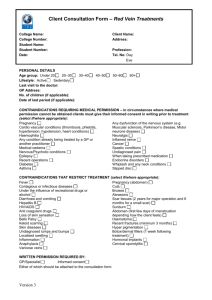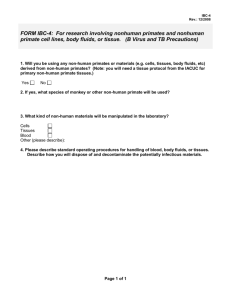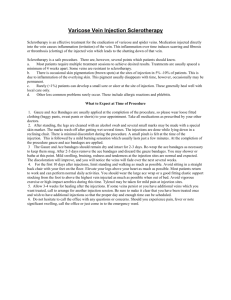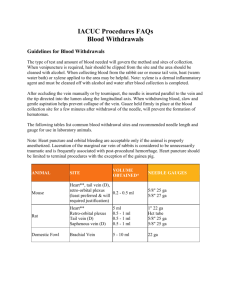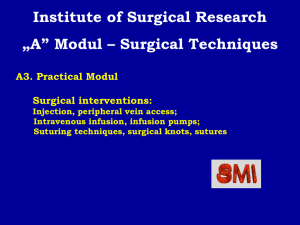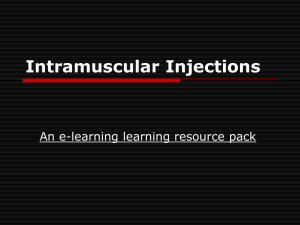4.1. The substance
advertisement
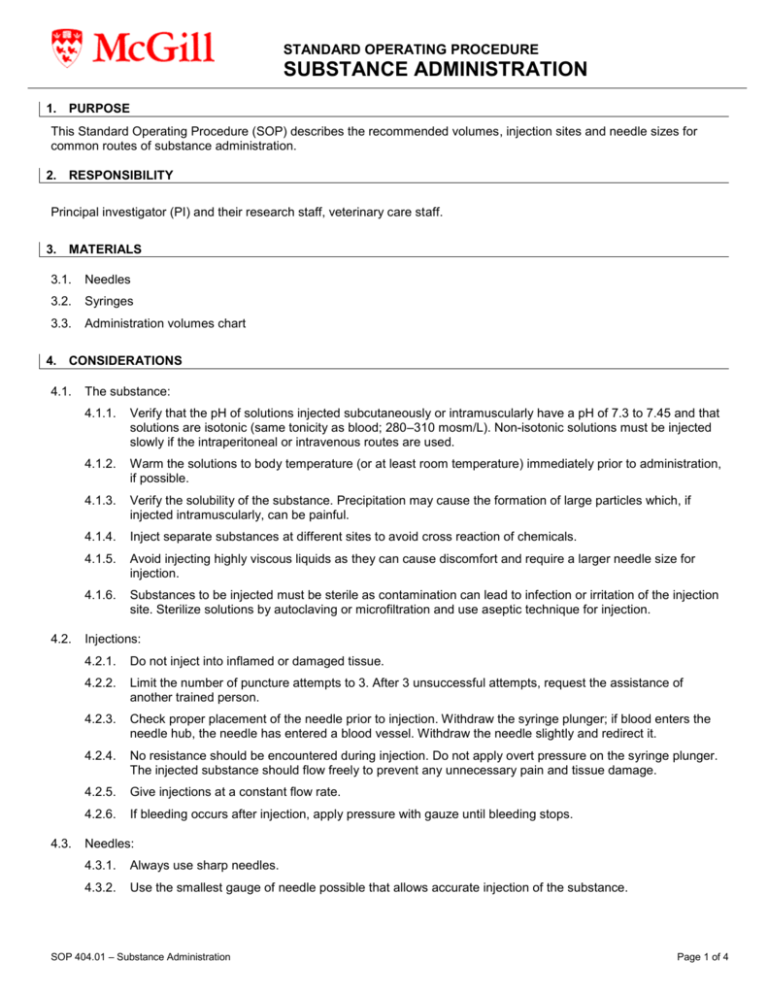
STANDARD OPERATING PROCEDURE SUBSTANCE ADMINISTRATION 1. PURPOSE This Standard Operating Procedure (SOP) describes the recommended volumes, injection sites and needle sizes for common routes of substance administration. 2. RESPONSIBILITY Principal investigator (PI) and their research staff, veterinary care staff. 3. MATERIALS 3.1. Needles 3.2. Syringes 3.3. Administration volumes chart 4. CONSIDERATIONS 4.1. 4.2. 4.3. The substance: 4.1.1. Verify that the pH of solutions injected subcutaneously or intramuscularly have a pH of 7.3 to 7.45 and that solutions are isotonic (same tonicity as blood; 280–310 mosm/L). Non-isotonic solutions must be injected slowly if the intraperitoneal or intravenous routes are used. 4.1.2. Warm the solutions to body temperature (or at least room temperature) immediately prior to administration, if possible. 4.1.3. Verify the solubility of the substance. Precipitation may cause the formation of large particles which, if injected intramuscularly, can be painful. 4.1.4. Inject separate substances at different sites to avoid cross reaction of chemicals. 4.1.5. Avoid injecting highly viscous liquids as they can cause discomfort and require a larger needle size for injection. 4.1.6. Substances to be injected must be sterile as contamination can lead to infection or irritation of the injection site. Sterilize solutions by autoclaving or microfiltration and use aseptic technique for injection. Injections: 4.2.1. Do not inject into inflamed or damaged tissue. 4.2.2. Limit the number of puncture attempts to 3. After 3 unsuccessful attempts, request the assistance of another trained person. 4.2.3. Check proper placement of the needle prior to injection. Withdraw the syringe plunger; if blood enters the needle hub, the needle has entered a blood vessel. Withdraw the needle slightly and redirect it. 4.2.4. No resistance should be encountered during injection. Do not apply overt pressure on the syringe plunger. The injected substance should flow freely to prevent any unnecessary pain and tissue damage. 4.2.5. Give injections at a constant flow rate. 4.2.6. If bleeding occurs after injection, apply pressure with gauze until bleeding stops. Needles: 4.3.1. Always use sharp needles. 4.3.2. Use the smallest gauge of needle possible that allows accurate injection of the substance. SOP 404.01 – Substance Administration Page 1 of 4 4.3.3. Recommended needle sizes (G): SPECIES INTRADERMAL SUBCUTANEOUS INTRAMUSCULAR INTRAPERITONEAL INTRAVENOUS Mouse 27 25 27 25-27 26-28 Rat 27 25 25 23-25 25-27 Rabbit 25 21-25 25 21-23 23-25 Hamster 25 25 25 25-27 25-27 Guinea pig 25 23-25 25 23-25 25-27 25 21-25 23-25 n/a 21-25 25 23-25 23-25 n/a 21-25 Dog 25 21-23 21-23 21-23 21-25 Cat 25 21-23 23 21-23 21-25 Sheep 25 19-23 21 19-21 19-21 Non-human primate (Rhesus or Cynomolgus) Non-human primate (Marmoset) 4.4. Volumes: 4.4.1. Use the smallest possible volume for injection. 4.4.2. Recommended volumes for substance administration: ORAL (ml/kg) SUBCUTANEOUS (ml/kg) INTRAMUSCULAR (volume/site) INTRAPERITONEAL (ml/kg) INTRAVENOUS BOLUS (ml/kg) INTRADERMAL (ml/site) Mouse 0 - 10 0 - 10 0 - 0.05 ml 0 - 20 0-5 0.05 – 0.1 Rat 0 - 10 0-5 0 - 0.1 ml 0 - 10 0-5 0.05 – 0.1 Rabbit 0 - 10 0-1 0 - 0.25 ml/kg 0-5 0-2 0.05 – 0.1 Hamster 0 - 10 0 - 10 0 - 0.05 ml/kg 0 - 20 0-5 0.05 – 0.1 Guinea pig 0 - 10 0-5 0 - 0.1 ml/kg 0 - 10 0-5 0.05 – 0.1 0-5 0-2 0 - 0.25 ml/kg n/a 0-2 0.05 – 0.1 0 - 10 0-2 0 - 0.25 ml/kg n/a 0 - 2.5 0.05 – 0.1 Dog 0-5 0-1 0 - 0.25 ml/kg 0-1 0 - 2.5 0.05 – 0.1 Cat 0-5 0-1 0 - 0.25 ml/kg 0-1 0 - 2.5 0.05 – 0.1 SPECIES Non-human primate (Rhesus or Cynomolgus) Non-human primate (Marmoset) SOP 404.01 – Substance Administration Page 2 of 4 4.4.3. If the volume administered must exceed the recommended volumes listed in section 4.4.2, justification must be provided and will require approval by the FACC. 4.4.4. Possible maximal administration volumes: ORAL (ml/kg) SUBCUTANEOUS (ml/kg) INTRAMUSCULAR (ml/kg/site) INTRAPERITONEAL (ml/kg) INTRAVENOUS SLOW INJECTION (ml/kg) Mouse 50 40 0.1 80 25 Rat 40 10 0.2 20 20 Rabbit 15 2 0.5 20 10 Hamster 50 40 0.1 80 25 Guinea pig 40 10 0.2 20 20 15 5 0.5 n/a n/a 15 5 0.5 n/a 10 Dog 15 2 0.5 20 5 Cat 15 2 0.5 20 5 SPECIES Non-human primate (Rhesus or Cynomolgus) Non-human primate (Marmoset) Sheep 5. PROCEDURES 5.1. Oral route (gavage): 5.1.1. 5.2. 5.3. Intranasal injections: 5.2.1. Brief anesthesia may be administered (e.g., isoflurane anesthesia). 5.2.2. Administer a maximum of 50µL to rodents and rabbits, 500µL to dogs. Intradermal injections: 5.3.1. 5.4. 5.5. Withdrawal of food prior to oral gavage is not required. Intradermal injection should be limited to 6 sites. Intramuscular injections: 5.4.1. Intramuscular administration should be limited to 2 sites per day. 5.4.2. Injection sites should be rotated. Intraperitoneal injections: 5.5.1. This technique is not recommended for pregnant animals or birds. 5.5.2. Limit intraperitoneal injections to once per day. 5.5.3. Osmotic minipumps can be surgically implanted intraperitoneally when repeated dosing is required. SOP 404.01 – Substance Administration Page 3 of 4 5.6. Subcutaneous injections: 5.6.1. Subcutaneous administration should be limited to 2 to 3 sites per day. 5.6.2. Osmotic minipumps can be surgically implanted subcutaneously when repeated dosing is required. 5.6.3. Recommended injection sites: SPECIES Mouse Scruff Rat Scruff Rabbit Scruff, flank Hamster Scruff Guinea pig Scruff, back Non-human primate (Rhesus or Cynomolgus) Non-human primate (Marmoset) 5.7. SITE Back Back Dog Scruff, back Cat Scruff, back Birds Medial thigh Intravenous injections: 5.7.1. Rotate injection sites, if possible. 5.7.2. Limit the number of punctures to 5 per site, per day. 5.7.3. For continuous infusion, indwelling catheters may be surgically implanted. 5.7.4. Recommended injection sites: SPECIES SITE Mouse Lateral tail vein Rat Lateral tail vein, sublingual vein, penile vein Rabbit Marginal ear vein Hamster Femoral or jugular vein Guinea pig Ear vein, saphenous vein, dorsal penile vein Non-human primate (Rhesus or Cynomolgus) Non-human primate (Marmoset) Cephalic vein, saphenous vein Dog Cephalic vein, saphenous vein Cat Cephalic vein, saphenous vein Comparative Medicine & Animal Resources Centre Page 4 of 4 SOP 404.01 – Substance Administration Written by: Jim Gourdon Reviewed on (yy-mm-dd):09-02-16 Revision #01 Effective (yy-mm-dd):09-02-16

